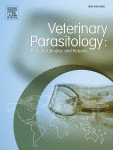Ver ítem
- xmlui.general.dspace_homeCentros e Institutos de InvestigaciónCICVyA. Centro de Investigación en Ciencias Veterinarias y AgronómicasInstituto de BiotecnologíaArtículos científicosxmlui.ArtifactBrowser.ItemViewer.trail
- Inicio
- Centros e Institutos de Investigación
- CICVyA. Centro de Investigación en Ciencias Veterinarias y Agronómicas
- Instituto de Biotecnología
- Artículos científicos
- Ver ítem
Polyparasitism and zoonotic parasites in dogs from a rural area of the Argentine Chaco
Resumen
Dogs play an important role as reservoirs and hosts of multiple pathogens shared with humans and wildlife, which contribute significantly to the global burden of disease. Here, we assessed the occurrence of a broad range of zoonotic and non-zoonotic parasites in dogs from a rural area in the humid Chaco; determined the occurrence of polyparasitism; and explored its association with selected risk factors. In total, 212 dogs were examined serologically to
[ver mas...]
Dogs play an important role as reservoirs and hosts of multiple pathogens shared with humans and wildlife, which contribute significantly to the global burden of disease. Here, we assessed the occurrence of a broad range of zoonotic and non-zoonotic parasites in dogs from a rural area in the humid Chaco; determined the occurrence of polyparasitism; and explored its association with selected risk factors. In total, 212 dogs were examined serologically to determine Trypanosoma cruzi infection and 152 of them also were examined for Ehrlichia canis, Borrelia bugderfori, Anaplasma phagocitophylum, Dirofilaria immitis and Toxoplasma gondii. Fecal samples from 85 dogs were examined for intestinal parasites. Seventeen parasite species were seen, 77% of which are zoonotic. The most prevalent parasites were Ancylostoma caninum (68.2%), T. gondii (55.3%, first report for dogs in Argentina), Giardia sp. (25.9%), Cryptosporidium sp. (20.0%), T. cruzi (16.5%), trematodes (15.3%) and Toxocara canis (14.1%). Polyparasitism was found in 96% of the dogs, with up to six parasite species in a single dog, and was significantly associated with age of dog but not with host body condition or sex. The most frequent pair of parasites found together were T. gondii-A. caninum (46%), A. caninum-T. cruzi (34%) and T. gondii-T. cruzi (27%). The prevalence of anemia and leukocytosis was significantly higher in dogs showing the worst body condition. Our findings likely reflect structural poverty, poor sanitation and lack of a safe water supply. Importantly, many of the prevalent parasites seen are threats to human health.
[Cerrar]

Autor
Enriquez, Gustavo Fabián;
Macchiaverna, Natalia Paula;
Argibay, Hernán Darío;
Lopez Arias, Ludmila Sol;
Farber, Marisa Diana;
Gürtler, Ricardo Esteban;
Cardinal, Martha Victoria;
Garbossa, Graciela;
Fuente
Veterinary Parasitology: Regional Studies and Reports 16 : 100287 (Abril 2019)
Fecha
2019-04
Editorial
Elsevier
ISSN
2405-9390
Formato
pdf
Tipo de documento
artículo
Palabras Claves
Derechos de acceso
Restringido
 Excepto donde se diga explicitamente, este item se publica bajo la siguiente descripción: Creative Commons Attribution-NonCommercial-ShareAlike 2.5 Unported (CC BY-NC-SA 2.5)
Excepto donde se diga explicitamente, este item se publica bajo la siguiente descripción: Creative Commons Attribution-NonCommercial-ShareAlike 2.5 Unported (CC BY-NC-SA 2.5)

